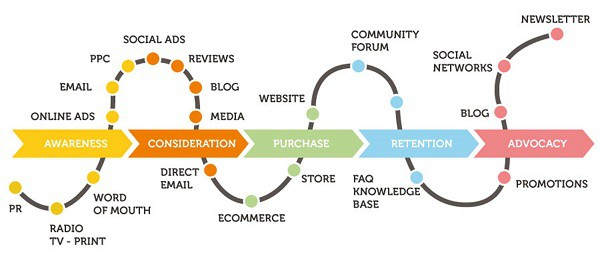The importance of streamlining customer touchpoints

.png)

.png)
Consider some of your most recent purchases. Do you remember how many touchpoints you made with the brand leading up to the purchase? Probably not, since consumers today have more touchpoints during their buyer journey than ever before.
The path to conversion is anything but linear. There are countless nuances that make up the buyer journey—even some that marketers will never be able to reconcile with consumer behavior. But mapping out the user journey, and where it intersects with your brand, can provide valuable insight into what your customers need and help you create more meaningful relationships with them.
We’d be willing to wager that “streamlining customer touchpoints” isn’t one of your top 5 marketing priorities for 2020. Read on to discover why it should be.
So, what exactly is a customer touchpoint? By definition, a customer touchpoint is any interaction a customer has with your brand. This can be on any platform and in any format.

Here are just a few examples of digital touchpoints:

From the list above it’s easy to see how quickly touchpoints add up during the purchase decision-making process these days. These statistics shed further insight:
A marketer’s goal should be to make each engagement with their audience meaningful. In order to accomplish this, you need to understand how and where your audience makes contact with your brand. From there, you can start to develop a communication strategy to streamline customer touchpoints for better UX:
Since today’s buyer journey is so unpredictable, it’s hard to know which channels they’ll engage with you on and which of these engagements will ultimately finalize their decision to purchase.
Start by analyzing your user data and see if any patterns emerge around which channels your audience frequents most as well as which lead to the highest conversion rates. That way you’ll know where to prioritize your efforts and can build out from there.
Having a cross-channel or omnichannel marketing strategy ensures that you don’t miss out on an opportunity to connect with audiences. Plus, the more interactions you have with your audience, the more chances to impress them and remain top-of-mind when they’re ready to convert.
Having a presence across multiple channels is one part of the equation. The other part is remaining consistent. Marketers are obsessed with thinking in channels but consumers are channel-blind—meaning they don’t consider the channel, just the interaction.
Consumers expect you to remember all engagements they’ve had with your brand, no matter how small it might seem. For example, if I’m browsing Nordstrom’s website and add a shirt to my cart, I expect it to appear in my mobile app as well.
The goal is to create a smooth and continuous brand experience that impresses your audience and leads them down a conversion path feeling confident about their purchase decision.
According to Google, 53% of shoppers say they always do research before they buy to ensure they are making the best possible choice. And while your brand’s clout is cumulative based on many factors and customer experiences, having the right messaging out there can help set the tone.
Customers doing product research want to quickly find accurate information about your product. The better you’re able to provide this to them, the more likely you are to leave a lasting impression.
Resources like help docs, knowledge bases, case studies, and online video tutorials can help you positively contribute to the conversation surrounding your brand. In-depth articles and webinars can position your company as a thought leader in your industry.
Mapping out your user journey, including all customer touchpoints, will give you better understanding of your real customer experience and can help you to create more cohesive experiences that ultimately lead to better conversion. It can also provide valuable insights into where you should be investing your marketing spend.
But touchpoints don’t end after the initial purchase. It’s important to maintain a dynamic, cross-channel messaging strategy that keeps users engaged and invested in your product well beyond sales and onboarding. After all, customer acquisition means nothing without retention.
Already have your customer journey mapped and are looking to optimize it? Learn how Appcues can help.